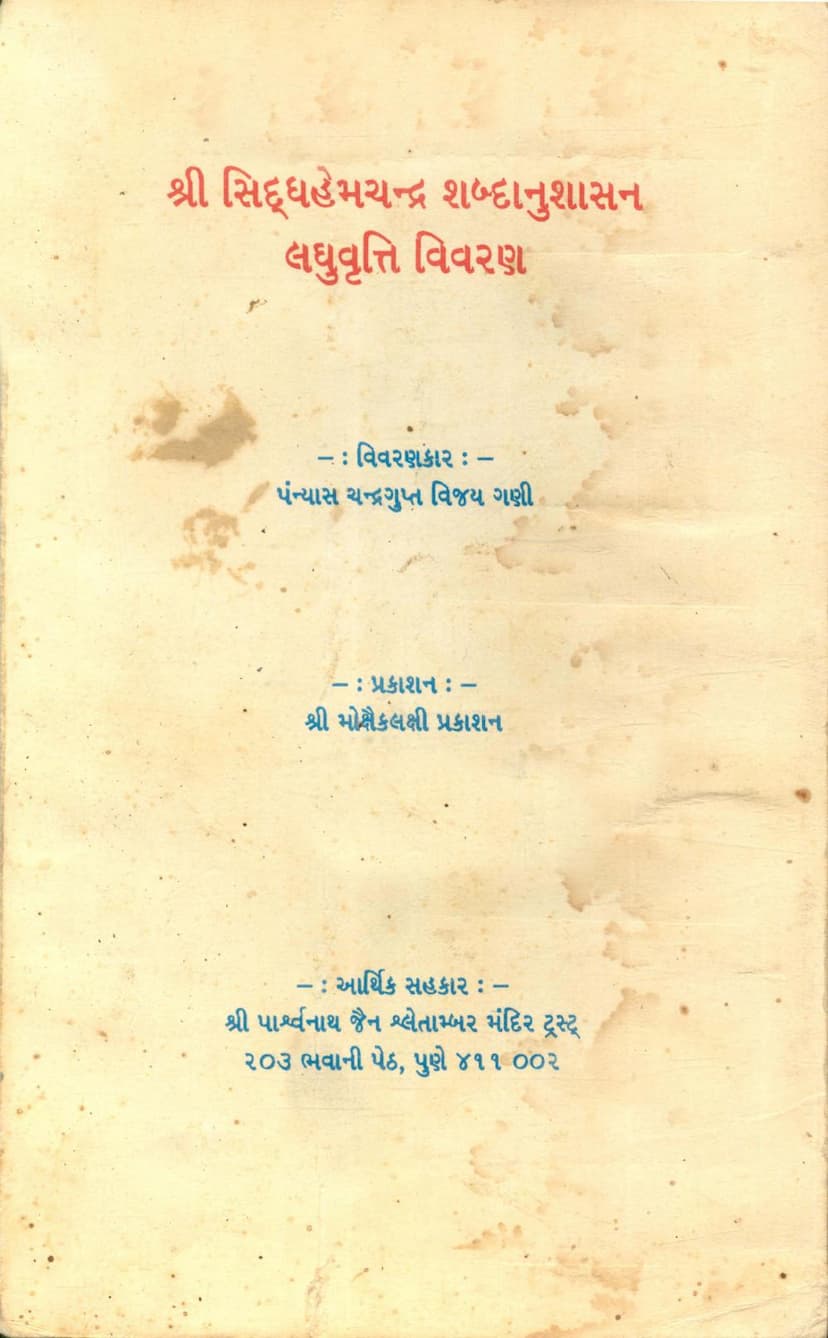Siddhhemchandra Shabdanushasan Laghuvrutti Vivran Part 01
Added to library: September 2, 2025

Summary
Here's a comprehensive summary of the provided Jain text, "Siddhhemchandra Shabdanushasan Laghuvrutti Vivran Part 01":
This document is the first part of a commentary (Laghuvrutti Vivran) on the Siddhhemchandra Shabdanushasan, a significant Jain grammar text authored by Acharya Hemchandracharya. The commentary itself is authored by Nyayacharya Chandragupta Vijay Gani. The publication is by Shri Molaikalaxmi Prakashan, with financial support from Shri Parshvanath Jain Shvetambar Mandir Trust, Pune.
Key Themes and Content:
- Purpose of the Commentary: The author states that the commentary aims to provide foundational and insightful knowledge of Sanskrit and Prakrit languages, specifically to help seekers (mumukshu) understand the profound meanings of Jain scriptures. It addresses the difficulties faced in studying and teaching grammar.
- Critique of Previous Commentaries: The author expresses a critical view of some previous commentaries, noting that some commentators, lacking a true understanding of grammatical terminology, have audaciously reviewed the sutras of the original author. The author questions why those who consider themselves proficient in grammar would attempt to comment on it in such a manner.
- Focus on Grammar: The primary focus of this volume is the detailed explanation of the initial chapters of the Siddhhemchandra Shabdanushasan, covering foundational grammatical concepts and terms.
- Key Grammatical Concepts Explained: The text meticulously explains various grammatical concepts through sutras and their elaborate explanations. These include:
- Pranidhana (Prostration/Salutation): The initial salutation to the Tirthankaras (Arhat) and the significance of the mantra "Arahant" is discussed, linking it to the concept of the soul's oneness with the Supreme Soul.
- Syadvada/Anekantavada: The fundamental Jain philosophical principle of Anekantavada (the doctrine of manifold aspects) is presented as crucial for understanding the genesis and nature of words in grammar. It emphasizes that words, like reality, possess infinite attributes, and their acceptance from different perspectives is essential for comprehending linguistic phenomena.
- Sanjnas (Technical Terms): A significant portion of the text is dedicated to defining and explaining various Sanskrit grammatical terms (sanjnas). These include:
- Swar (Vowels): Classification of vowels based on length (Hrasva, Deergha, Pluta) and their characteristics.
- Nami: A specific category of vowels with particular grammatical rules.
- Samaan (Same): Terms related to vowels with similar phonetic qualities.
- Anuswar and Visarg: Explanation of nasal and guttural sounds.
- Vyanjan (Consonants): Definitions and classifications of consonants, including those in different vargas (classes), and terms like Ghosh (voiced), Aghosh (unvoiced), and Antastha (semivowels).
- Shith: A specific term related to certain sounds or letters.
- Svar (Vowels) and their classifications: Detailed discussion on various vowel types, including their place of articulation (sthana) and effort (prayatna), leading to complex classifications (e.g., 18 types of 'a' sounds).
- Pratyay (Suffixes): Introduction to case suffixes (e.g., Jas, Shas, Bhyam, Bhis) and their grammatical significance.
- Pad (Word): The concept of a word and how it is formed through the combination of roots and suffixes.
- Sit (S-initial suffix) and Sit (T-initial suffix): Specific grammatical rules related to suffixes beginning with 's' and 't'.
- Vritti (Compound): The explanation of how words form compounds and the concept of pararthābhidhāyi (indicating meaning beyond the individual words).
- Sentence (Vakya): Definition of a sentence as a combination of words expressing a complete thought.
- Nam (Noun): The definition of a noun as any meaningful word that is not a verb root, inflectional ending, or sentence.
- Guna and Vriddhi: Phonetic changes that occur to vowels under specific grammatical conditions.
- Sandhi rules: Extensive rules governing the combination of sounds and letters, including changes like gUṇa, vR^ddhi, lopa (deletion), ādeśa (substitution), and āgama (insertion).
- Avyaya (Indeclinables): Explanation of indeclinable words that remain unchanged.
- Samjnā (Technical Terms): A systematic explanation of numerous technical terms used in Sanskrit grammar, categorized by their function or nature.
- Philosophical Underpinnings: The commentary consistently integrates Jain philosophy, particularly Anekantavada, into the grammatical explanations, demonstrating how these principles are essential for understanding the nuances of language as used in the scriptures.
- Scholarly Approach: The author displays a deep understanding of grammatical traditions, referencing earlier works and providing critical insights into linguistic rules.
- Target Audience: The text is intended for those seeking a serious study of Sanskrit and Prakrit for devotional and spiritual purposes, particularly monks and nuns (Sadhu-Sadhvi Ji M.). The publication emphasizes that the entire sale proceeds will go to the knowledge department of the supporting trust, urging lay followers (shravaks) to contribute and use the book for spiritual upliftment, not for livelihood.
Structure:
The provided text covers the first chapter (Prathama Adhyaya) of the grammar, divided into four parts (Padas). The excerpt showcases the detailed explanation of sutras related to:
- Chapter 1, Pada 1: Introduces basic concepts like prostration, vowels, and initial rules.
- Chapter 1, Pada 2: Focuses extensively on vowel and consonant changes (sandhi rules), including various types of adaptations and their specific contexts.
- Chapter 1, Pada 3: Continues with consonant changes, assimilation rules, and specific phonetic transformations.
- Chapter 1, Pada 4: Deals with pronouns, case endings, noun formation, and various rules governing their application.
In essence, the "Siddhhemchandra Shabdanushasan Laghuvrutti Vivran Part 01" is a rigorous and philosophically grounded commentary on Jain grammar, aiming to illuminate the path of scriptural study for spiritual seekers by demystifying the intricacies of Sanskrit and Prakrit language.